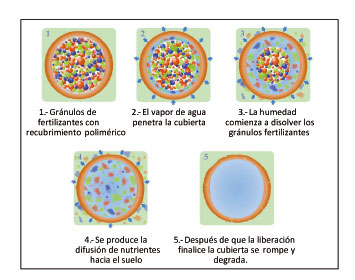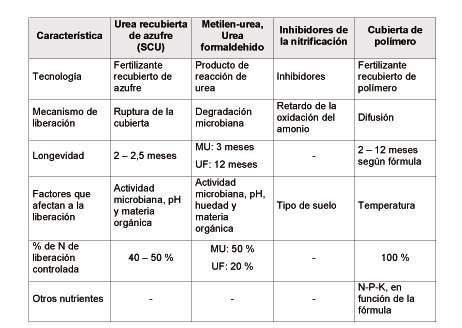This news article was originally written in Spanish. It has been automatically translated for your convenience. Reasonable efforts have been made to provide an accurate translation, however, no automated translation is perfect nor is it intended to replace a human translator. The original article in Spanish can be viewed at
Principales tipologías de fertilizantes utilizados en la agriculturaThe fertilisation has to provide to the plant the nutrients that at the same time keep the fertility of the floor
Main typologies of fertilizantes used in the agriculture
José Manuel Fontanilla and Alberto Outeiriño (Haifa Iberia)
José Nolasco (Engineer Agronomist)31/01/2012
31 January 2012
For his correct development, the plants need the suitable nutrients in each one of his stages. A good balance goes to allow obtain a nutrition balanced chord to the needs of the crop along all his cycle of development. The fertilisation has to provide to the plant these nutrients at the same time that keeps the fertility of the floor, without affecting negatively to the environingingment. Thus it is important to know the characteristics of the main typologies of fertilizantes existent at present in the market.
Fertilizantes Conventional
This type of fertilizantes characterises for having a lower cost and, when being very soluble in the solution of the floor, provide a fast availability of nutrients for the plant. This fast availability no always goes to be positive since it carries associated important losses of nutrients by leaching and volatilisation, mainly of nitrogen, what reduces the efficiency of the fertilisation (until in 70%), forcing to apply more fertilizante of the necessary to compensate the losses, as well as to fractionate the contributions realising more applications, with the consequent increase in time and hand-held needs of work. All this supposes losses of units fertilizantes and greater pollution of groundwaters and superficial.
With the utilisation of fertilizantes of slow release and of release controlled reduce the losses, by what keeps in the floor the suitable level of nitrogen along the cycle of development of the plant
Like solution to the negative appearances of the conventional fertilisation arise the fertilizantes of slow release or controlled, that go to supply the nutrients to the plant of a more effective form, controlled and prolonged in the time. This allows to reduce the number of applications and of units fertilizantes to contribute, allowing a nitrogenous fertilisation more effective. With the utilisation of fertilizantes of slow release and of release controlled reduce the losses, allowing keep in the floor the suitable level of nitrogen along the cycle of development of the plant, avoiding the excess or the defect that characterises to the traditional applications. To this it is necessary to add him the reduction of the hand-held needs of work and use of machinery when diminishing the number of applications and the quantity of fertilizante.
Urea recubierta Of Sulphur (SCU)
It is a type of fertilizante encapsulado that obtains rociando sulphur grinded on granules of urea sobrecalentados. To reduce the possible imperfections and orifices that create in this cover of sulphur during the process, seals later with a layer of wax. It is frequent the apparition of granules with holes without sealing, what causes that it splits of the nitrogen goes to lose the characteristic of slow release. After this initial release and until the rest of the granules begin to free the nitrogen, produces a period in which it descends of important form the availability of this nutrient. The process of release initiates once that the bacteria of the floor of the gender 'Thiobacillus' oxidan the layer of sulphur of the granules without imperfections. The activity of these bacteria goes to see favoured by the humidity of the floor, the temperature, a neutral pH, as well as the high content in organic matter, factors that go to influence therefore directly in the release of the nitrogen and in the longevity of the product.
Metilen-urea / Urea Formaldehyde
They are fertilizantes formed by the reaction of the urea with formaldehyde, giving place to mixes of urea and chains of polymers of different lengths, depending this length of the conditions of the reaction as well as of the existent proportion between the urea and the formaldehyde. The release of the nitrogen is caused by the split of these chains by the action of the microorganisms of the floor, increasing the speed of release what minor was the length of the chains. Since the solubility depends also of the length of the chain, to measure the slow release of a fertilizante uses the designated Index of Activity (IA) determined by the following equation:
Index of Activity = (Fraction II) / (Fraction I + Fraction III)
Being the Fraction I the compound by the soluble nitrogen in cold water (20 °C) and therefore available quickly for the plant. The Fraction II is formed by the soluble nitrogen in hot water (100 °C), that will be freed in the weeks to come or months and that constitutes the nitrogen of slow release properly said. The Fraction III would be constituted by the no soluble nitrogen in hot water and that therefore will not be available for the plant. The Index of Activity for this type of fertilizantes is used to to find between 40 and 60. When depending the release directly of the microbial activity, goes to see affected by all the factors that affect it (temperature, pH, humidity and organic matter).
Inhibidores Of the nitrification
They are compound chemists that go to delay the activity of the Nitrosomonas, the responsible bacteria of the transformation of the ammonium in nitrite, previous stage to his transformation in nitrates by the action of the bacteria Nitrobacter and Nitrosolobus, being the nitrates the form in which they produce the main losses of the nitrogen applied in the fertilisation by his ease of wash. During this period and from his application, the nitrogen amónico that contain the fertilizante contributed will follow being available for the plant. The time that keeps the nitrogen in shape amoniacal depends of the type of floor.
Covers to base of biodegradable polymers
In this type of fertilizantes encapsulados the nutrients find recubiertos by layers of biodegradable polymer that go to allow his release of form controlled in function of the temperature of the floor. Therefore, it will produce a greater release when this increases, what coincides with the increase of the needs of the plants. This technology is the only that allows to control the release of any nutrient, when being susceptible all they to be encapsulados. When finding the nutrients encapsulados, can apply of form located near of the system radicular by not existing problems owed to the excess of any of the elements nutrients. Once applied, the fertilizante of release controlled absorbs the humidity, what dissolves the nutrients of the interior but without freeing them, being the rhythm of release regulated only by the temperature of the floor, that initiates of slow and precise form the release of nutrients to the zone radicular (Fig. 1). The resistance of the cover goes to keep the integrity of the particles along the time and of the manipulation. Inside this last group finds the range of fertilizantes of release controlled of Haifa Chemicals Ltd especially designed for the fertilisation of the crops (Cote N mix).

It appears 1: Mechanism of release controlled of a fertilizante encapsulado with biodegradable polymers.
This type of fertilizantes achieves:
- An optimum availability of nutrients through all the cycle, avoiding deficiencies or excesses of nutrients.
- Saving in hand of work to the not having to fractionate the applications.
- Reduction of the losses of nutrients by wash when going freeing them little by little.
- Improvement of the efficiency in the use of nutrients by the crops.
- Application of dose more precise, avoiding the accumulation of salts and the pollution of the groundwaters.
The Table 1 sample the technologies described in the present article, indicating his main characteristics.
Table 1: Comparative between the different technologies of fertilizantes of slow release and controlled.
Related Companies or Entities








